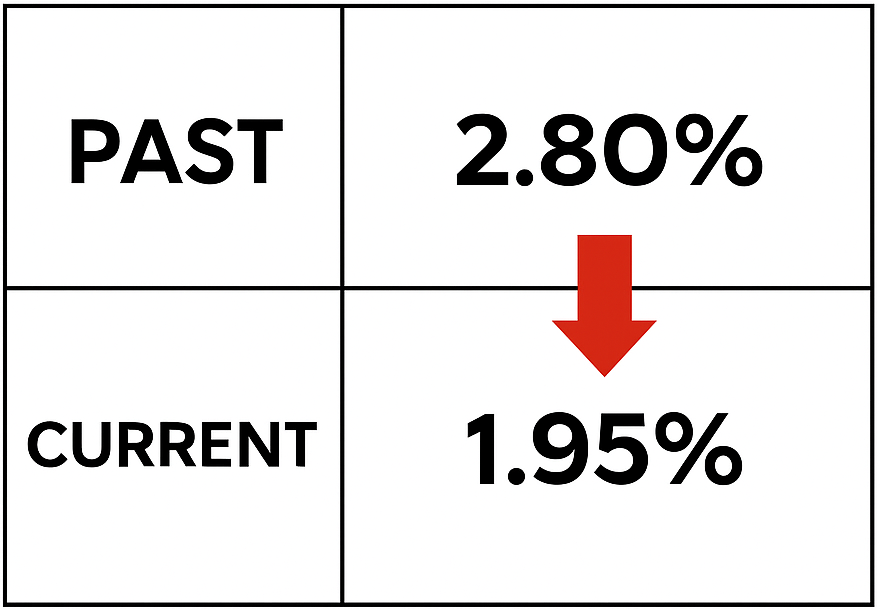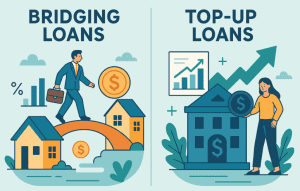Floating interest rates are back in the spotlight — and for good reason.
They often start lower than fixed rates, which means potential savings if the timing’s right. But they also move with the market. That means your monthly repayments can go up… or down.
In this guide, we’ll cover how floating rates work, who should consider them, and what you really need to know before choosing one. Before deciding, try this mortgage loan calculator to see how different rates affect your monthly payments.
What Is a Floating Interest Rate and How Does It Work?
Floating interest rates are home loan rates that change over time. Unlike fixed rates, which stay the same throughout your lock-in period, floating rates rise or fall based on market conditions — especially rates like SORA (Singapore Overnight Rate Average).
In short, you could be paying less one year… and more the next.
In my opinion, if you’re comfortable tracking the market and want to save more in the short term, a floating package can work in your favour. But it’s not for the faint-hearted.
How does it compare with fixed rates in real-world terms?
When deciding between floating and fixed rates, it helps to see the key differences side by side. The choice isn’t just about numbers — it’s about how much certainty you want versus how much flexibility you can handle.
Let’s break it down simply.
📊 Fixed vs Floating Mortgage Interest Rate Comparison
| Feature | Fixed Rate | Floating Rate |
|---|---|---|
| Rate Stability | ✅ Locked for 2–5 years | ❌ Changes quarterly (e.g. 3M SORA) |
| Initial Interest | 🔺 Usually lower | 🔻 Slightly higher |
| Monthly Repayment | 🚫 No change during lock-in | 🔄 Can increase or decrease |
| Lock-In Period | 🔒 2 to 3 years typically | 🔓 Some with 1-year lock-in or none |
| Repricing Flexibility | ❌ Limited | ✅ Often includes free repricing |
| Suitable For | Risk-averse, stable income buyers | Rate-savvy or short-term owners |
- Fixed rates give peace of mind. Your monthly repayments don’t change during the lock-in.
- Floating rates often start cheaper but can fluctuate every few months.
Think of fixed as a safety net, and floating as a chance to ride the waves — potentially saving more, but only if the water stays calm.
What’s the formula behind floating interest in Singapore?
In Singapore, most floating rates are pegged to SORA, with a spread added by the bank.
Here’s the typical formula:
Floating Rate = SORA (3M) + Bank Spread
Fixed Rate Home Loan Comparison (Singapore – May 2025)
| Bank | Rate | Tenure | Min Loan |
|---|---|---|---|
| DBS | 2.55% | 2 / 3 / 5 Years | $100,000 |
| OCBC | 2.60% | 2 / 3 Years | $100,000 |
| UOB | 2.58% | 3 Years | $100,000 |
| HSBC | 2.68% | 2 / 3 / 5 Years | $200,000 |
| MayBank | 2.50% | 5 Years | $100,000 |
Floating Rate Home Loan Comparison (Singapore – May 2025)
| Bank | Rate | Tenure | Min Loan |
|---|---|---|---|
| DBS | 2.90% | No Lock-in / 2 Years | $100,000 |
| OCBC | 2.85% | 2 Years | $100,000 |
| UOB | 2.95% | 2 Years | $100,000 |
| HSBC | 2.80% | No Lock-in | $200,000 |
| MayBank | 2.80% | 2 Years | $100,000 |
For example, if 3M SORA is 3.7% and your bank’s spread is 0.8%, your effective interest rate becomes 4.5%.
Every 3 months, SORA is updated — and your rate adjusts. Banks like DBS, UOB, and OCBC all offer SORA-pegged packages. You can explore each one here:
Expert tip: The “spread” never changes during your lock-in period — but SORA does. That’s why it’s key to track market movements or work with a trusted mortgage broker who’ll keep you updated.
Why do banks adjust floating rates — and how often?
Banks adjust floating rates to reflect market changes. In Singapore, the main driver is SORA, which is influenced by global economic trends and local monetary policy.
Key points:
- SORA is published daily, but home loans are usually based on the 3-month average (3M SORA).
- Your rate is typically reviewed and updated every 3 months.
- If SORA rises, so do your repayments.
In late 2024, SORA hovered around 3.7% — a jump from just 0.2% a few years ago. This shows how rates can swing fast.
If you’re unsure whether a floating rate suits your risk profile, it may help to check out this guide to refinancing options — many homeowners switch when rates move unfavourably.
Why Take a Floating Interest Rate in 2025?
With rising borrowing costs and global market shifts, more Singaporeans are starting to ask: Is it finally time to go floating?
In 2025, the gap between floating and fixed home loan rates has widened again — and that could mean real savings for savvy borrowers.
Let’s look at why floating loans are making a comeback this year.
Why are floating rates currently cheaper than fixed?
The short answer? Banks are pricing in uncertainty.
Fixed rates are generally higher because they offer stability — especially when inflation and interest rates are expected to rise. In contrast, floating rates follow SORA, which has started to stabilise after peaking in 2024.
Floating vs Fixed Home Loan Rates in Singapore - Q1 2025
| Loan Type | Average Rate (Q1 2025) |
|---|---|
| Fixed Rate (2Y) | ~4.2% |
| Floating Rate (3M SORA + spread) | ~3.6% to 3.9% |
Here’s a tip: The spread for floating loans typically stays fixed for your lock-in period. That makes them a smart choice when you expect rates to dip or stabilise — like now.
Want to compare actual rates from banks? Start with a simple overview of DBS, OCBC, and UOB home loans.
What flexibility do floating loans offer during refinancing?
One major advantage of floating packages is their built-in flexibility.
Many borrowers who take floating packages:
- Skip heavy lock-in penalties
- Can refinance earlier when better deals come up
- Are not tied to promotional fixed rate periods
Let’s say you’ve taken a 3M SORA-pegged loan. If rates drop next year, you can refinance to a lower spread or fixed package — often without paying high exit fees.
Personal take: If you expect the market to shift soon, a floating loan keeps your options open. You’re not locked into a “wait-and-see” mode.
Check out refinancing options for HDB and private loans if you want to plan ahead.
How can floating loans help you capitalise on rate cycles?
Floating loans can be powerful — if you know how to use them.
Unlike fixed packages that offer rate certainty, floating loans let you ride the market cycle. That means you can benefit when SORA dips, especially in the short term.
Here’s how some buyers use this to their advantage:
- Refinance regularly to optimise interest savings
- Pair with shorter loan tenures to minimise exposure
- Use savings for partial repayments during low-rate periods
According to MAS, the 3M SORA has started to flatten — signalling we may be nearing the top of the current cycle.
My advice is to always plan for some buffer in case rates climb unexpectedly. If you don’t like surprises, talk to a mortgage broker who can monitor and advise you when to switch.
Types of Floating Rate Packages in Singapore
Not all floating rate loans are created equal. In Singapore, banks usually offer two main types: SORA-pegged loans and board rate loans. While they may look similar at first, the mechanics — and risks — are quite different.
Understanding the differences can save you from unwanted surprises down the road.
What is a SORA-pegged loan and why is it transparent?
A SORA-pegged loan is tied to the 3-month SORA (Singapore Overnight Rate Average). This is a benchmark rate published by MAS and based on actual overnight borrowing transactions between banks.
Why borrowers like it:
- It’s transparent — SORA is published daily on MAS’s website.
- It’s market-based — not controlled by the bank.
- It’s usually reviewed every 3 months (3M SORA).
Here’s how a typical SORA-pegged loan works:
Your Rate = 3M SORA + Bank Spread
E.g. 3M SORA (3.6%) + Spread (0.7%) = Effective Rate (4.3%)
Expert tip: If you’re the kind who tracks market data and doesn’t mind some fluctuation, SORA loans offer solid visibility and potential savings.
Want to explore real examples? Compare options like the UOB Home Loan or OCBC Home Loan — both offer SORA-based packages.
Why are board rate loans less predictable?
Board rate loans, on the other hand, are internal rates set by the banks. They don’t follow SORA or any external benchmark.
What this means for you:
- The bank decides when and how much to adjust your rate.
- No transparency — the formula isn’t disclosed.
You’re relying on the bank’s goodwill.
SORA vs Board Rate: Key Differences for Homeowners
| Loan Type | Transparent? | Pegged to Market? | Bank-Controlled? |
|---|---|---|---|
| SORA-Pegged | Yes | Yes | No |
| Board Rate | No | No | Yes |
My personal take? Unless you have a very short-term holding period, I’d avoid board rates. They’re riskier and harder to plan around — especially if you’re managing tight cash flow.
How do banks calculate spreads and margins?

Every floating loan has two parts:
- The benchmark rate (e.g. SORA)
- The spread (the bank’s profit margin)
The spread is typically:
- 0.6% to 1.2% for most SORA loans
- Locked in during your loan’s lock-in period
- Negotiable (especially with a good mortgage broker)
Pro tip: Even a small change in spread can mean thousands of dollars over your loan tenure. If you’re buying a condo or private property, use this loan comparison guide to make sure you’re not overpaying.
If you’re unsure what spread you qualify for, chat with a mortgage specialist — or use a refinance calculator to simulate your savings.
Floating vs Fixed: What’s the Right Fit for You?
Choosing between a floating or fixed home loan isn’t just about interest rates — it’s about knowing your own risk appetite, timeline, and future plans.
Let’s break down who should go for what.
What kind of buyer benefits most from floating loans?

Floating loans are great for buyers who:
- Expect interest rates to drop or stabilise
- Plan to refinance within 1–3 years
- Have cash flow flexibility to handle small rate changes
- Like the idea of staying agile and watching market cycles
This could be you if you’re a younger buyer, upgrading soon, or even an investor eyeing shorter-term gains.
Expert tip: A floating rate also works well if you plan to sell the property before the end of the lock-in period. That way, you benefit from the lower initial rate without worrying about long-term volatility.
If this sounds like you, explore flexible refinancing options or compare packages using the loan calculator.
When does a fixed-rate offer better peace of mind?
Fixed-rate packages suit those who:
- Prioritise stability and peace of mind
- Are buying a home for own-stay, especially as a family
- Want to lock in a rate now to protect against market volatility
Don’t want to monitor SORA every few months
Fixed vs Floating: Which Home Loan Suits Your Profile?
| Scenario | Best Option |
|---|---|
| First-time buyer with kids | Fixed Rate |
| Investor holding <3 years | Floating Rate |
| Unsure about refinancing | Fixed Rate |
| Actively track markets | Floating Rate |
I do think that fixed loans may cost a little more, but they help you sleep better. If you’re already stretching your budget, that predictability matters.
Need help weighing both sides? Reach out to a mortgage broker who can match your profile to the right fit — without bank bias.
Can you switch from floating to fixed later on?
Yes — and many smart borrowers do.
This strategy is called restructuring or repricing. It lets you:
- Start with a floating loan to enjoy lower rates
- Switch to a fixed package later if rates start rising
- Avoid the hassle of a full refinancing (if staying with the same bank)
Timing matters. You’ll need to watch when your lock-in period ends and whether your bank allows repricing without penalty.
Planning to refinance or switch packages in the next 1–2 years? Use this refinancing guide to explore your options — especially if you’re on an HDB loan.
Real Impact: How Floating Rates Affect Monthly Repayments
Floating loans can save you money — or cost you more — depending on how interest rates move.
If you’re on a SORA-pegged loan, every few months brings the possibility of change. And that change hits where it matters most: your monthly mortgage payment.
Let’s break down what that looks like in real life.
How Rising SORA Rates Affect Your Monthly Home Loan Repayment
| 3M SORA Rate | Spread | Effective Rate | Monthly Payment |
|---|---|---|---|
| 3.00% | 0.8% | 3.8% | ~$2,584 |
| 3.70% | 0.8% | 4.5% | ~$2,778 |
| 4.20% | 0.8% | 5.0% | ~$2,924 |
That’s nearly $340 more per month when SORA rises by just 1.2%.
Expert tip: Always leave room in your monthly budget for at least a 1–1.5% increase in rates. It’s not about panic — it’s about planning. Want to run your own numbers? Try this repayment calculator to see how future changes might affect you.
What should you budget for during market volatility?
Floating rate borrowers should build in flexibility. Here’s how:
- Set aside 3–6 months of emergency funds
- Budget for $300–$500 more per month than your current repayment
- Reassess your loan every 6–12 months — especially if you’re nearing lock-in expiry
If you’re on a tight budget or nearing retirement, a fixed-rate plan might suit you better — or consider shorter loan tenures to limit exposure. Some homeowners also choose to refinance to a better spread once their lock-in ends. Check out refinancing tips here.
How do banks notify you about rate changes?
Most banks:
- Review your loan every 3 months (if on 3M SORA)
- Send you a letter or email 1–2 weeks before the new rate kicks in
- Update the new monthly repayment amount in your internet banking or GIRO schedule
That said, not every bank explains the details clearly.
Honestly, try setting a calendar reminder every quarter to review SORA and your bank notice. Or ask your mortgage broker to do it for you — many offer ongoing monitoring at no cost.
Not sure how your bank updates your rate? If you’re using board rate loans, updates might be even less predictable — which is why SORA-pegged packages are often preferred for their clarity.
Rate Trends, Economic Outlook, and Expert Insights
Before committing to a floating interest rate, it’s worth understanding where things might be headed. Interest rate trends don’t move in a vacuum — they’re closely tied to global economic conditions, inflation, and central bank policy.
Let’s look at what experts are saying in 2025 — and what you should watch for.
What do MAS and economists project for interest rates?
As of Q2 2025, the 3M SORA sits around 3.7%, following a steady climb over the last two years.
According to the Monetary Authority of Singapore (MAS), inflation has started to moderate, and interest rate hikes may be nearing their peak. Several banks and analysts expect rates to:
- Hold steady or dip slightly in late 2025
- Stabilise in the 3.0%–3.5% range through 2026
- Avoid another sharp hike unless inflation spikes again
Expert tip: If you’re planning to refinance, this could be a window to lock in a strong spread — before the next market cycle kicks in.
Want to explore refinancing for your HDB or condo? Start here:
HDB Home Loan
Private Property Loan
Is now a good time to enter with floating loans?

For many buyers, yes — if you’re strategic.
Here’s why:
- Floating rates are still lower than fixed rates in most cases
- SORA has shown signs of plateauing
- You can refinance or switch to fixed later when the market shifts
But it depends on your profile:
Floating vs Fixed: Which Loan Works for Your Buyer Profile?
| Profile | Floating Loan? | Fixed Loan? |
|---|---|---|
| Investor with short horizon | Yes | Less suitable |
| First-time buyer (tight cash flow) | Risky | Safer pick |
| Upgrader planning to sell soon | Flexible | Less relevant |
Based on my personal experience, if you can handle short-term rate changes and want to save over the next 12–24 months, floating loans still offer upside. Just be prepared to act when rates shift again.
What does historical data tell us about SORA movements?
Let’s zoom out. SORA replaced SIBOR officially in 2021 — and here’s what we’ve seen since:
SORA Rate Trends in Singapore (2021–2025)
| Year | Avg 3M SORA |
|---|---|
| 2021 | ~0.20% |
| 2022 | ~1.80% |
| 2023 | ~2.90% |
| 2024 | ~3.60% |
| 2025 (YTD) | ~3.70% |
SORA has been more stable than SIBOR in the long term — and reflects actual interbank lending rather than bank-set rates. That’s why many borrowers trust it more when choosing a floating package.
Looking ahead, the trend suggests we’re at or near the peak — making 2025 a potential sweet spot to ride the tail end of high rates before a likely dip.
Need help tracking this over time? Bookmark the Ace Mortgage blog — we update rate trends, lender changes, and strategies every month.
Smart Mortgage Planning Tips with Floating Rates
Floating rates can work in your favour — but only if you plan ahead.
Here are some real-world strategies to manage the risks and get the most out of your mortgage.
How can you use refinancing to your advantage?
Refinancing is one of the most powerful tools for floating-rate borrowers. If your loan is approaching the end of its lock-in period or if spreads have improved, you can switch to:
- A lower spread on a new floating package
- A fixed-rate plan for stability
- Another bank offering better perks or flexibility
Expert tip: Don’t wait until rates spike again. You can start planning your refinancing 6 months before your lock-in ends.
Use this time to:
- Get updated loan offers
- Check how your total loan balance compares using a refinancing calculator
Speak to banks or a broker to understand repricing options
Should you keep a cash buffer for sudden rate hikes?
Yes — and here’s why.
Floating interest rates move with SORA. And while the trend may stabilise in 2025, no one can predict sudden rate hikes with 100% certainty.
A good rule of thumb:
- Set aside $300–$500/month extra, based on your loan size
- Keep 3–6 months of repayments in your emergency fund
- If possible, make partial repayments when rates are low
It’s better to be slightly over-prepared than to get caught off guard by a rate spike. This is especially true for buyers on HDB loans with tighter budgets.
Can a mortgage broker help you monitor better deals?
Absolutely — especially if you’re too busy to track rates yourself.
A good mortgage broker in Singapore will:
- Compare all banks’ floating and fixed packages for you
- Advise when it’s time to refinance or reprice
- Handle paperwork, application, and follow-ups
- Keep you updated on SORA movements and new bank promos
If you’re not actively watching the market, having a broker is like having a GPS for your mortgage. You still drive — but with fewer wrong turns.
Best part? Broker services are typically free for borrowers, as banks pay the referral fee.
Bonus: Floating Loan Hacks Most Borrowers Miss
Most homeowners stop at the basics. But the smartest borrowers know how to stack the odds in their favour.
Here are a few underrated strategies to get the most out of your floating rate package.
How to combine floating loans with shorter tenures smartly
Shorter loan tenures + floating rates = more control.
Here’s why:
- You pay off your loan faster while minimising exposure to long-term rate hikes
- You reduce total interest paid over the loan’s lifespan
- You stay nimble for future upgrades or investments
But this only works if:
- You have stable income
- You’re comfortable with higher monthly repayments
- You want to finish your mortgage by a specific age (e.g. before 55)
Expert tip: A 20-year floating loan could save you thousands compared to a 30-year tenure, if you’re disciplined. You can simulate the difference with a repayment calculator.
Why some investors pair floating rates with rental income
If you’re buying a condo or private property to rent out, floating loans may work in your favour.
Why?
- Rental income provides monthly cash flow to buffer interest hikes
- You can offset part of the mortgage cost during high-rate periods
- Many investors refinance quickly to chase better spreads or short-term promos
This works especially well for:
- Condo investors
- Buyers of 2-bedroom units with high rental demand
- Owners with strong tenant retention and stable yields
Investor tip: Don’t just look at interest rates — compare net rental yield vs effective mortgage cost. If yield stays above 4.5%, a floating loan with a 3.8–4.2% rate could still make sense.
What tools or apps help you track SORA trends monthly?
Keeping up with SORA doesn’t have to be tedious. Try these tools:
- MAS SORA Dashboard: See the daily and historical 3M SORA trend
- Loan calculators: Like this mortgage repayment tool
- Rate tracking spreadsheets: Set alerts for monthly changes
- Newsletters or blogs: Follow updates via the Ace Mortgage blog
Personal pick: Bookmarking the MAS dashboard and setting quarterly Google Calendar alerts is a simple yet powerful habit. You’ll always be one step ahead of your next rate adjustment.
Final Thoughts — Should You Go Floating in 2025?
Floating interest rates can be a smart move — if you know how to ride the wave.
They offer flexibility, lower starting costs, and the chance to save when rates dip. But they also require planning, monitoring, and a bit of risk tolerance. In 2025, with SORA showing signs of stabilising, many homeowners are finding that the benefits may finally outweigh the uncertainty.
Our take? If you’re financially stable, thinking short-term, or ready to refinance smartly, floating might just be your best bet this year.
Need help deciding or comparing across banks? Let us simplify it for you — no sales pitch, just real advice.
Speak to a trusted mortgage broker now
Or explore your best home loan options here














